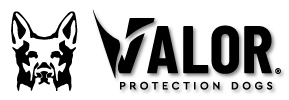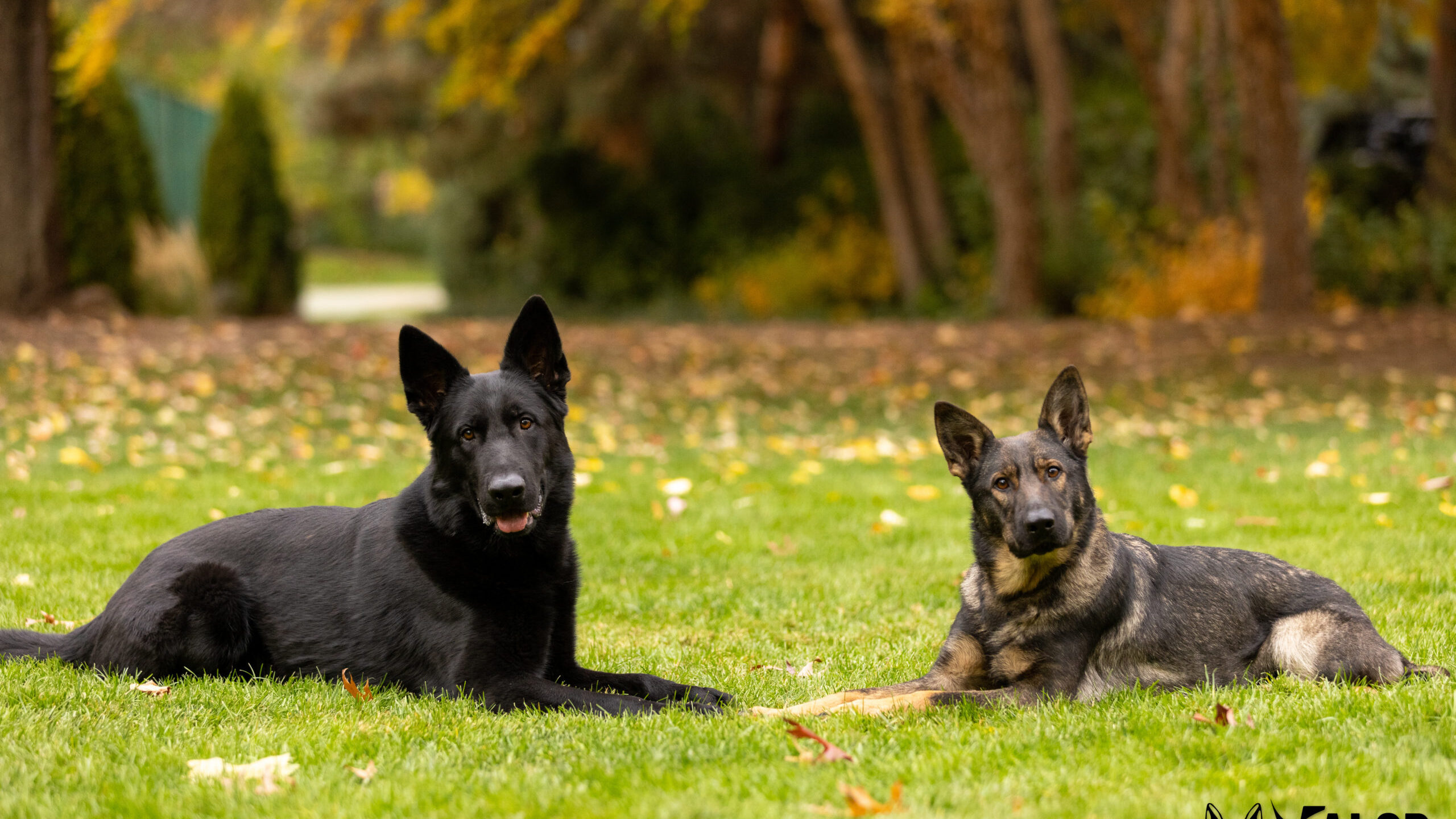When it comes to Personal Protection Dogs, we strive to exceed industry standards. One way we do that is by extensively health testing our protection dogs who are home-raised and professionally trained. We do this testing prior to selling them so that buyers rest assured knowing they’re buying the most perfect protection dog possible, in every possible way- health, temperament and training.
We use the best health testing in the industry: Embark, OFA and PennHIP. By doing so, we are doing everything we can to ensure our buyers are purchasing a sound and healthy K9. Name another protection dog sales company that does that!
In addition to the health testing we do, our dogs come from top European bloodlines with fully health tested parents, grandparents, great-grandparents and so on. When it comes to genetic excellence, the deck is certainly stacked in our favor!
In this article, we discuss what we do and why to better educate our buyers.
Embark DNA health testing our protection dogs
Good health starts with good genetics. Embark is the leading dog DNA testing company and the highest-rated dog DNA test on the market. Its process identifies breed makeup and potential genetic health conditions. It is the only canine genetics company that uses a research-grade DNA genotyping platform to ensure accurate results.
The Embark test checks for over 200,000 genetic markers including breed-relevant conditions. That’s simply incredible!
For German Shepherds, breed-relevant conditions include the following:
- Degenerative Myelopathy, DM
- Multiple Drug Sensitivity
- Hemophilia A
- Hemophilia A, Canine Leukocyte Adhesion Deficiency Type III, CLAD III
- Platelet Factor X Receptor Deficiency, Scott Syndrome
- Day Blindness
- Urate Kidney & Bladder Stones
- Anhidrotic Ectodermal Dysplasia
- Renal Dystadenocarcinoma and Nodular Dermatofibrosis
- Mucopolysaccharidosis Type VIII, Sly Syndrome, MPS VII
All of the above are serious, crippling and expensive health problems that would absolutely impair any protection dog and render him incapable of performing his job. These are all issues prevalent in the German Shepherd breed due to over-breeding and careless breeding.
Degenerative Myelopathy, especially, is a terrible disease that causes progressive paralysis. It is an inherited neurological disorder of dogs similar to Lou Gehrig’s disease in humans. Affected dogs usually present clinical signs in adulthood (at least 8 years of age) with gradual muscle wasting and loss of coordination that typically begins in the hind legs because of nerve degeneration. At its end stages, it results in complete paralysis and, ultimately, death.
Orthopedic Foundation for Animals (OFA)
A breeder once said, “Bad elbows are the gift that keep on giving.” Any good breeder is careful to breed only dogs with genetically good elbows. We believe that, likewise, any good protection dog company should be cautious to only sell dogs with good elbows: genetically or otherwise.
We believe in and use the Orthopedic Foundation for Animals (OFA) to screen all of our dogs at 12 months of age. The OFA was founded and originally incorporated as a private not-for-profit foundation in 1966. Its initial mission was to provide radiographic evaluation, data management and genetic counseling for hip dysplasia. Today its mission is: “To improve the health and well-being of companion animals through a reduction in the incidence of genetic disease.”
When evaluating a dog for elbow dysplasia, the radiograph needs to be the extreme flexed medial to lateral view of each elbow, which can only be done by OFA certified veterinarians.
The OFA radiologists receive the x-rays for interpretation and analysis. For elbow evaluations, results are determined to be either Normal (radiographically normal elbows with no sign of dysplasia or injury) or Abnormal (radiographically abnormal elbows with radiographic changes associated with secondary degenerative joint disease, also known as dysplasia). The only rating for normal Elbows is Normal. Abnormal elbows are rated Grades I-III.
Preliminary evaluations are available for dogs over 4 months of age and under 24 months of age. We test our dogs at 12 months of age. To publish preliminary results, the dog must be at least 12 months of age at the time of radiograph, and the dog must be permanently identified via a microchip or tattoo.
For more information regarding the OFA, go to https://www.ofa.org/
Below are examples of OFA elbow x-rays. These x-rays belong to Dahlia z Jirkova dvora aka Freya. She received an official OFA preliminary rating of Normal which is what we want.
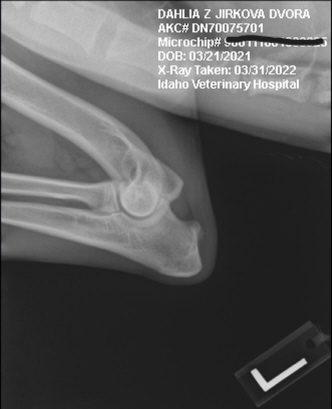
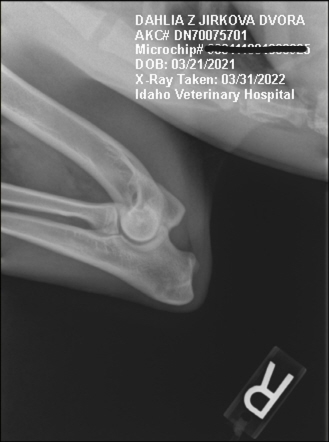
PennHIP
Valor Protection Dogs utilizes the University of Pennsylvania Hip Improvement Program (PennHIP) Rating System to obtain hip scores on our dogs. The PennHIP method has a strong scientific foundation as the most effective, facts-based hip screening tool available for dogs.
The PennHIP is a multifaceted radiographic screening method for hip evaluation. The technique assesses the quality of the canine hip and quantitatively measures canine hip joint laxity. The PennHIP method of evaluation is more accurate than the current standard for its ability to predict the onset of osteoarthritis (OA). Osteoarthritis, also known as Degenerative Joint Disease, is the hallmark of canine hip dysplasia (CHD).
The PennHIP method is a novel way to assess, measure, and interpret hip joint laxity. It consists of three separate radiographs: the distraction view, the compression view and the hip-extended view.
- The distraction view and compression view are used to obtain accurate and precise measurements of hip laxity and congruity, respectively
- The hip-extended view, sometimes called the OFA view, is used to obtain supplementary information regarding the existence of OA of the hip joint
OFA is the singular, subjectively-scored, hip-extended radiograph, which is the conventional radiographic view used by all hip screening systems globally to evaluate the integrity of the canine hip joint. However, the PennHIP technique is more accurate than the Orthopedic Foundation for Animals (OFA) standard as it has been shown to be a better predictor for the onset of OA.
PennHIP is the program of choice for many dog programs, including Vapor Wake K9, which invests heavily into their K9s and wants to know which dogs have the best prognosis for long-term hip health both for working lifespan and for breeding purposes.
PennHIP testing is accurate in puppies as young as 16 weeks of age. A dog’s hip laxity at 16 weeks of age will be much the same at one year, two years and older. We at Valor Protection Dogs test our dogs around 12 months of age.
A score between 0-1 is assigned, with 0 being very tight hips and 1 being very loose. The test is not pass-fail, and the score is actually based on a measurement of the hip’s distraction index (DI). According to the organization, “the DI is an indication of the ‘percent out of joint’ that the femoral head is displaced from the acetabulum.” So a DI of 0.15 means the femoral head is 15 percent out of joint (a very tight hip), and a DI of 0.77 means the head is 77 percent out of joint (a somewhat loose hip).
The index is measured using circular gauges that are placed over the films, and the final number reflects factors such as the size of the dog and how it compares to the rest of the population.
For PennHIP information, visit https://antechimagingservices.com/antechweb/pennhip
Below is an example of a hip extension view for Protection Dog Rip. He received a PennHIP rating of 0.28 which is excellent! The lower the number, the better.
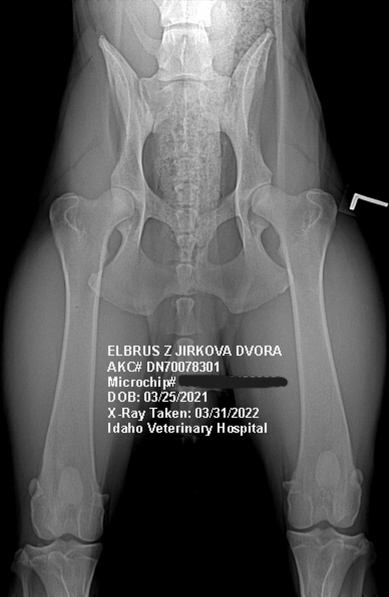
Health Testing Results for our Protection Dogs in-Training
Three of our dogs so far have been fully health tested. Links to their results are published here:
- Protection Dog Rip’s Health Testing
- Protection Dog Freya’s Health Testing
- Protection Dog Zion’s Health Testing
Stay tuned for the others!
No other company
No other company does extensive health testing for protection dogs like we do. Why?
Because firstly, it’s expensive. Health testing costs on average $1000+, per dog, for the Embark DNA test, a vet appointment, x-rays of hips (multiple views), x-rays of elbows (multiple views) and for submissions to PennHIP and OFA. The cost of health testing alone is a big expense for companies looking to make the maximum profit possible off each dog.
Secondly, many companies do not possess quality dogs like we do, so they know their dogs will not pass health testing. They claim their dogs are “health” and “vet-checked” to trick buyers into thinking that is all there is to it. They want to make money and are not interested in health testing protection dogs. They turn a blind eye to to make a quick profit and hope their buyers do the same.
Lastly, those companies already know their dogs either do not have good hips and elbows or inherited a crippling disease. Perhaps that’s why the dog was sold to them in the first place. Good breeders don’t sell their best dogs; they keep them! Thus, they try to disguise their dogs’ issues by avoiding the topic of health testing altogether.
Many buyers, unfortunately, are not well-educated and believe what they are told. Saying a dog is “Healthy” does not mean the same thing for every company. We strive to educate our buyers so they can make an informed decision.
We know that protection dog training and sales is a high-risk, high-reward business. We do everything possible to set ourselves up for success genetically by purchasing only top puppies and by raising our puppies carefully to protect their joints and fuel their bodies with optimal, top-of-the-line nutrition. To read more about our dogs’ nutrition, click here.
We know what most other companies are doing (and not doing), and we are actively going above and beyond every day to raise the bar in the protection dog industry.
Interested in purchasing a protection dog?
If you are looking for a top Protection Dog for your home and family, look no further. Our German Shepherds are the best of the best. To learn more about our protection dogs for sale, please visit our Dogs for Sale page or call me (Amy) directly at 208-577-0744. Valor Protection Dogs is located in Boise, Idaho.
